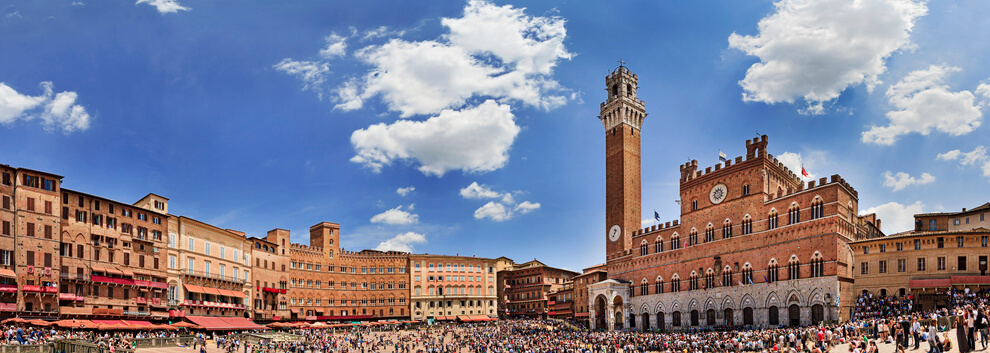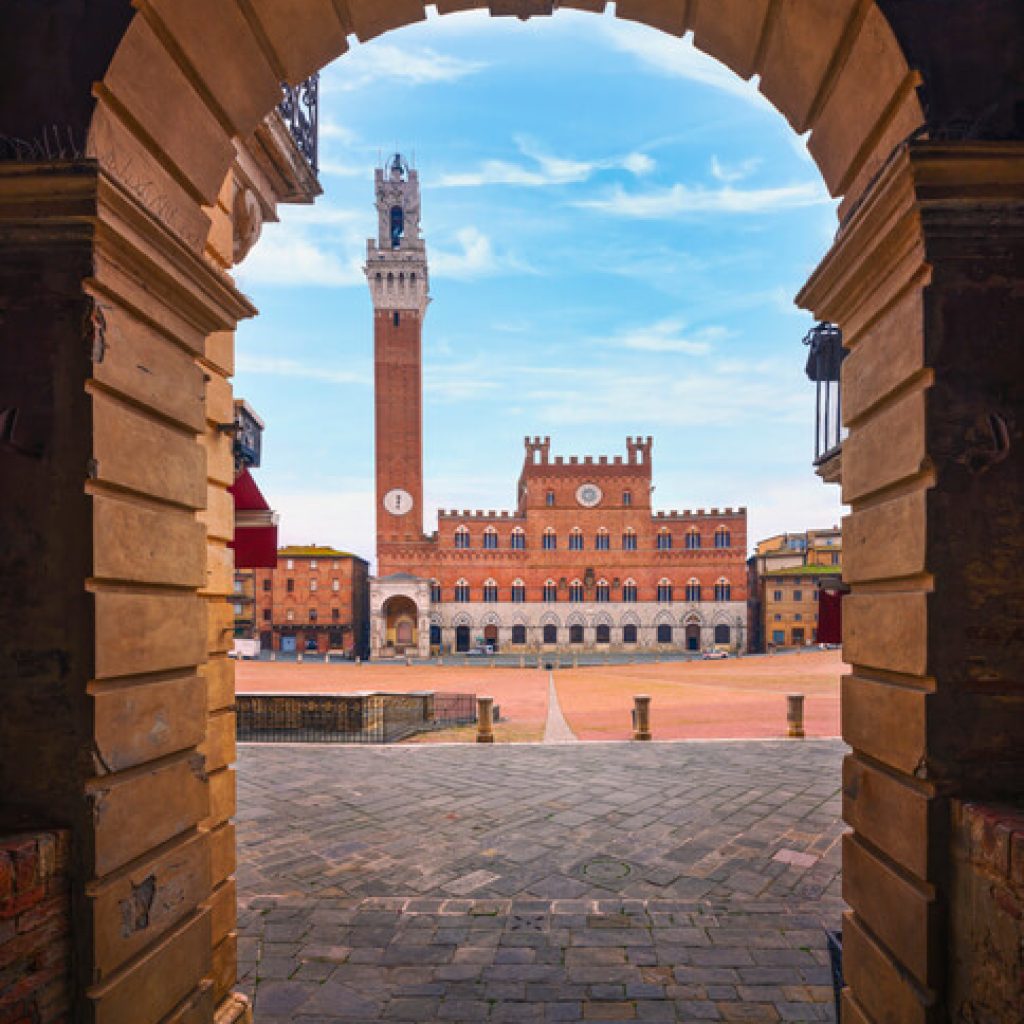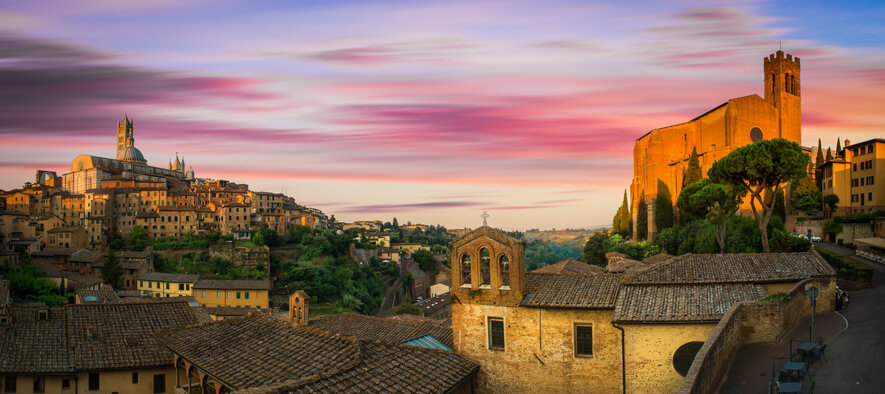Siena
Siena, Italy

It’s widely believed that Siena was founded by Senius, the son of Remus who was also attributed to the founding of Rome. After Remus was murdered by Romulus, Senius, together with his brother, Aschius, fled and settled on one of Siena’s hills. Because of this, the city is filled with statues and emblems of the lupa or she-wolf who fostered Remus and Romulus.
In the 13th century, Siena reached its peak with the formation of the Republic of Siena where it became the home of one of Italy’s first banking systems, one that prospered throughout all of Europe. To add, the Via Francigena which comfortably sat across the city paved the way for barter and trade among neighboring cities. Siena’s banking center and access to trade led to the city’s rise, making it a rival to its nearest city, Florence.
Like all other great cities, Siena suffered its own decline because of the Black Plague in 1348. After the plague, the city failed to regain its wealth, resulting in a stop on the city’s architecture and development which until now, remains to be how it looked like back then. A lot of Siena’s buildings looked frozen in time, contributing to the city’s aesthetic which tourists nowadays appreciate, especially for those with old souls.
Currently, Siena boasts its 13th-century architecture, a seemingly fine rarity in most European cities that have renovated most of its buildings. While neighboring cities have a rich Renaissance history, Siena is known for the entire aesthetic of being an open-air museum. Perfect for the romantics, it offers a medieval ambiance unique to the city. With that, Siena is usually added to a Florence trip since the two cities are near each other. On its own, Siena is ever-present on a Tuscany tour. For tourists who wish for a medieval and secluded feel, Siena is the perfect city to explore.
Siena is Tuscany’s central city. It was an Etruscan settlement at first and was later founded by Senio and Ascanio, sons of Remus and nephews of Romulus. By the 6th century AD, the Lombards and the Franks started to govern the city and became a self-governing commune in the 12th century. The city of Siena became the center of pro-imperial Ghibellinism in Tuscany when Economic Rivalry and Territorial conflict with the city of Florence emerged. Their political success peaked when the Sienese army defeated the Florentines during the Battle of Montaperti in the 1260s.
By the 13th century, Siena became a banking center but could not surpass Florence’s rival city. The popes then charged economic sanctions to Siena’s Ghibelline merchants when the imperial government caused a widespread negative impact on the city’s political, social, and cultural life. Ghibelline lost its power to Siena as it turned into a Guelf faction.
Siena was one of the cities that suffered from countless wars and famine when the Black Death outbreak in 1348 happened, and Italy experienced a general economic decline in the 14th century. The people of Siena strived hard to enrich their city by constructing one-of-a-kind palaces, towers, fountains and bringing importance to religion by building churches and cathedrals. Despite the economic stagnation, their city continued to suffer until Pandolfo Petrucci, an exiled aristocrat, seized power in 1487-1512. Siena surrendered to the Spaniards in 1555, ending the Republic and included in the new Kingdom of Italy and the rest of Tuscany in 1861.
Today, you can still appreciate the history of Siena through its rich culture breathtaking architecture that has preserved its medieval character. In fact, out of the 7 sites recognized by the UNESCO World Heritage, 4 of them can be found in the province of Siena.

Top Attractions
- Duomo (Siena Cathedral)
- Built during the 13th and 14th centuries, the Duomo is a medieval church in Siena that features Romanesque-Goth architecture with the interior having 56 panels that showcase both historical and biblical scenes done by around 40 artists since the 14th century. Alongside these is Giovanni Pisano’s white, green, and red marble facade. The pulpit was carved by Nicola Pisano and the sculptures were made by Michelangelo, Donatello, and Gian Bernini.
- Duomo di Siena or Siena Cathedral was constructed between the early and mid 13th centuries. It has a unique Gothic style with a hexagonal base and Mosaic floors. Its facade, located on the west side of the cathedral, combines French, Romanesque, and classic gothic architecture.
- Piazza del Campo
- The Piazza del Campo, also known as Il Campo, is Siena’s historic social square. Having majestic architecture, it is considered to be the greatest medieval square in Italy and even in Europe. It used to be a Roman marketplace before the mid-12th century and currently, it is where locals and tourists relax over coffee and drinks. The Palazzo Pubblico and the Torre del Mangia can also be found in the piazza, making it a one-stop wonder.
- Recognized by UNESCO World Heritage, Piazza del Campo is considered one of many beautiful squares in Italy. It has a circumference of 333 meters and has explicitly 9 sections. Each section symbolizes the 9 governors with the most peaceful governments in Italy.
- Museo dell’Opera
- The Museo dell’Opera is Siena’s art museum which is home to artworks that were originally from the Duomo. One of these is the Duccio which shows the Virgin Mary with the angels, saints, and citizens of Siena. Some of Giovanni Pisano’s sculptures are also found here like the 12 statues of prophets and philosophers. Other art pieces include the stained-glass window by Duccio and the Nativity of the Virgin by Pietro Lorenzetti.
- Pinacoteca Nazionale
- The Pinacoteca Nazionale is another of Siena’s museums that features late medieval and some Renaissance paintings. Similar to other Sienese museums, it has religious images and scenes painted with gold across the walls. However, unlike those in Florence, the artworks featured here have a Byzantine and Gothic style which is attributed to the decline Siena experienced during the renaissance. These include Guido da Siena’s St. Peter Enthroned, Simone Martini’s Blessed Agostino Novello and His Miracles, and Bartolo di Fredi’s Adoration of the Magi.
- Complesso Museale di Santa Maria della Scala
- Originally built as a hospital for the poor, the sick, and pilgrims of the Via Francigena, the Complesso Museale di Santa Maria della Scala now stands as a museum with a rich history of being one of Europe’s first hospitals. Its pieces include Jacopo della Quercia’s original 1419 sculptures from the Fonte Gaia and a fresco cycle by di Pietro showing the Articles of the Creed.
- Palazzo Pubblico e Museo Civico
- The Palazzo Pubblico and Museo Civico are located in Pizza del Campo’s main square. It functions as the city’s town hall, but great secular art pieces can also be found.
- Torre del Mangia
- Torre del Mangia was constructed from 1325-1348 and is 102 meters tall. It is strategically built to look the same height as the bell tower of Duomo di Siena at a certain angle. This represents the equal sovereignty between the civic authority and the church.
- National Art Gallery of Siena
- The Siena National Art Gallery displayed paintings made by Sienese Painters from the 13th to the 18th century. Some of the notable paintings that can be seen there are the “Annunciazone” by Ambrogio Lorenzetti and the Spannocchi-Piccolomini collection.


Facts
- Siena is a city in Tuscany that has a population of approximately 54,000. It used to be the capital of the former republic of Siena until 1559. The people of Siena’s primary language is primarily the Tuscan dialect. Still, they also considered the Italian language as their first language to unify different parts of Italy with one common tongue.
- The city of Siena is built on 3 hills and has 17 districts. Those districts are united twice a year to attend Palio di Siena.
- Palio di Siena is a horse race event held every July 2nd and August 16th. It is held in Piazza del Campo, where horses run in circles and consists of 3 laps.
- Monte Dei Paschi di Siena, constructed in 1472 and considered the oldest bank in the world, is found in Siena.
- Touring the city is best done without a car because of its auto traffic restriction, especially within the old city’s walls.
- Siena is famous for its confectioneries and other sweet treats made of honey when it comes to food.
- Wednesdays in Siena are market day. The market in La Lizza is full of vendors that sell a variety of food, fresh produce, and even souvenirs for tourists. Streets start to fill up with tourists and locals as it opens from 8:30 am to 1:30 pm.
Aside from a good shopping experience, Siena offers food that you will remember for ages. One of Siena’s specialties is the pici which is a Sienese type of spaghetti sauteed with pepper and cheese or tomato sauce with some white wine. For meat lovers, there is the T-bone steak perfect with pecorini, a local specialty cheese from sheep’s milk. You can also try out capocollo and finocchiona which are cured meats made in Siena.
To finish off the mentioned delectable food, Siena offers one of the best wines in the region. Every bar and restaurant across town has one to offer. Choose from their extensive wine list that’s perfect for Sienese cheese and meat. There are also wine tours of some vineyards in the countrysides, offering you a first look and taste of Italy’s finest wines. In restaurants, you can totally ask the local servers for the best wine they have!

